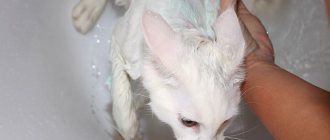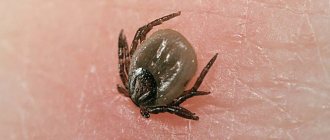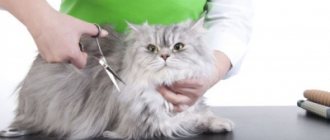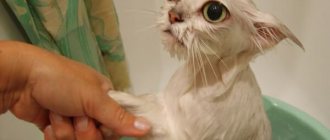Many lovers of mustachioed and tabby cats are interested in the question - what kind of cats love water and whether, in principle, there are such breeds that are loyal to swimming and water splashes. After all, one of the most established stereotypes about cats is their fear of water. Owners often prepare to bathe their furry friend as if they were going to a real war, seriously fearing that their affectionate and flexible pet will fight for the dryness of its fur coat as if it were the last frontier.
In fact, there are breeds of cats that, in principle, are not afraid to swim, and all other purrs can be accustomed to water procedures so that they, at a minimum, proceed calmly. Today we will talk about cats that like water, and also share the secrets of teaching cats to bathe.
What cats love water?
How often should you bathe at home?
Cats are very clean animals; they regularly clean themselves. However, situations still arise from time to time when it is necessary to bathe your pet. If the cat gets dirty, before a show, as prescribed by a veterinarian (for some dermatological and parasitic diseases) and for other reasons.
If the owner prefers regularly scheduled bathing, such events should not be carried out too often. The fact is that during bathing, especially with the use of shampoos, the protective fat layer is washed off from the cat’s skin and fur, which leads to dryness, dandruff, weak hair, and can later result in dermatitis, eczema and other skin diseases.
Warning! You definitely need to pay attention to cat cosmetics - shampoos, soaps, conditioners, etc. Human hygiene products that are also intended for other animal species should not be used.
So how much bathing is recommended? Healthy cats are washed no more than once every 2–3 months, or less often. Long-haired pets, such as the Nibelung, sometimes have to be washed almost every month, because such hair becomes more dirty and tangled. Be sure to thoroughly dry the coat after the procedure, comb it and, if necessary, style it. In general, the average number of cat baths per year is 2–5.
If the pet has contaminated some part of the body, for example, the paws or tail, it would be more advisable to clean this area separately rather than wash the cat entirely. This is especially true for those cats that walk outside every day.
Furminator comb for long-haired cats, how to use it correctly and how to choose
Why bathe a cat?
The cleanest animal on the planet is a cat, of course, provided that it is healthy. She takes care of her fur herself, licking it literally centimeter by centimeter, removing microparticles of dust. The more she travels through her territory, the more meticulously she licks her fur, licking away dirt and unpleasant odors. Seeing such neatness, it is difficult to understand why the animal needs to be washed. They cope well with this task on their own. The tailed princesses lived in villages for centuries, caught rats, and no one ever bathed them. Why did they start doing this now? Maybe this is nothing more than a tribute to fashion?
Let's go back 100 years to a small village. The rivers have clean water, lush greenery grows around, birds sing, there are no garbage dumps or landfills. Pure ecology and grace. What's outside the window today? Exhaust fumes, viruses and germs, dirty basements, acid rain. All this settles on the cat's fur. It is impossible to see the danger with the naked eye, but this does not mean that it does not exist. But the problem is much more serious than it seems, because all harmful substances enter the gastrointestinal tract, causing diseases. And washing a cat is much easier than treating it for diseases.
Frequent bathing can also be dangerous. You need to understand that the fur is covered with a protective lubricant, which is produced by the subcutaneous sebaceous glands. And frequent washing can deprive the cat of its natural protection. It is advisable to wash your cat 2-3 times a year, but this does not apply to washing dirty paws.
And if the animal does not leave the apartment, it means it does not collect dangerous microbes and substances from the street. Maybe you don't need to wash it? Experienced breeders say that there is a fair amount of dirt and danger within the apartment. And you shouldn’t give up water procedures, although they can’t be done that often.
There are direct indications for bathing representatives of the feline family:
- Heavily contaminated wool, regardless of the origin of the contamination - synthetic or natural.
- Presence of parasites.
- For preventive purposes.
There is one more point that you need to remember - this is molting. When a cat licks itself, hair gets into the stomach, and during the molting period its amount increases several times. It may be difficult for an animal to cope with its elimination naturally, which negatively affects the digestive system. To avoid troubles, the bathing schedule must be drawn up so that the procedure coincides with the molting period.
Contraindications for swimming:
- You should not bathe a sick animal.
- There should be at least 4 hours between bathing and eating. Under no circumstances should you send your cat to the bathroom on a full stomach.
- There is no need to create stressful situations (turn on the water loudly, rattle basins, etc.).
- Long-haired cats need to be brushed well before bathing.
- Frequent bathing can harm your pet.
Before considering the procedure itself, it is worth choosing the right shampoos for washing.
Some prejudices
There is a category of owners who claim that cats should not be washed at all. Some explain this by saying that water is destructive for these animals, which is why cats avoid it on an instinctive level, while others believe that since a cat licks itself every day, this is absolutely enough for it to maintain cleanliness.
In fact, such a judgment is incorrect. Almost all cats do not like water, since this is not their natural environment and the feeling of being wet and cold is very unpleasant for them. Pets are especially frightened by the flow of water rumbling in the shower, since cats’ hearing is much sharper than that of humans and the noisy hissing flow makes them nervous, associating them with danger. Cats consider water to be something destructive, but moisture does not pose a threat to them. On the contrary, sometimes bathing is simply necessary for your four-legged friend.
Bathing a cat in the sink
In fact, cats are good swimmers; there are some that happily splash in the water, play and bask in the shower. This is normal, although unusual.
There is no need to worry about this and you can easily allow your pet to have plenty of contact with water. It is only important to make sure that after such procedures the pet does not freeze.
Other owners fanatically wash their pets almost every day, in order, in their opinion, to keep the pet’s beautiful fur clean, give it a pleasant aroma and an attractive shine. The result of such care can be disastrous - skin irritation, wounds, ulcers, dandruff and flaking, dullness, hair loss and many other health problems.
Any extremes in caring for pets are inappropriate. Wrong attitude and lack of necessary knowledge often harms the health of the pet. It is also important to take into account the breed of the cat and select cosmetics and a bathing schedule for each individual. An attentive owner always has questions while keeping a pet, so do not hesitate to seek advice from a professional.
What cats love water?
Despite the facts we have listed above, some cats are not deterred by the risk of infection or hypothermia, and even an attack by a larger predator does not frighten them. Almost all wild cats, regardless of size, regularly enter the water: to hunt fish or waterfowl, and sometimes just for pleasure.
Many wild cats enjoy bathing
Such wild representatives of the cat family as tigers, Sumatrans, servals, jaguars, wiverins splash in the water with pleasure, and even play with the splashes and waves. There is even an Asian cat, which is called a fish cat - it lives near the water and feeds exclusively on fish. The fish cat dives well and swims confidently, getting food.
Domestic cats that are not afraid of bathing are also common. Many pets drink water from an open tap or toilet, play with the water stream, and some even jump into the shower or bathtub, despite the water being turned on or the shower running. There are even unique people who take water treatments together with their owners, completely voluntarily!
There are cats that can play in the water for hours
How to do it right
Bathing can be divided into several stages:
- preparing the necessary supplies and bathing area;
- preparing the cat;
- bathing;
- care after washing.
First you need to decide where it will be more convenient to carry out water procedures. You can prepare the bath by laying a non-slip mat on the bottom to make the cat feel more confident. The bath is a common place for bathing, but there is some inconvenience - the owner will have to remain in an uncomfortable position for quite a long time, leaning towards the pet.
A good option is to use a sink if its volume allows you to comfortably accommodate your pet. Some owners bathe cats in a basin. This is convenient, since the basin can be placed anywhere and any size can be selected; an alternative is to use a baby bath. However, you should be very careful - cats almost always try to break free and run away, while clinging tightly to the edges of the pelvis, which is why it can easily roll over. Water from such a bath often ends up on the floor and on the owner.
Having decided on a place, you need to place the necessary things nearby:
- shampoo (soap);
- ladle;
- several towels;
- comb (comb, slicker brush - depending on the breed of the pet and the type of its coat);
- scissors or a tangle cutter (in case you have to cut off an unnoticed tangle);
- hairdryer (if the cat is okay with this kind of drying);
- peroxide, iodine, cotton pads (for treating wounds if the cat does scratch the owner);
- goodies for the cat.
Select a suitable water temperature. It should be pleasantly warm - approximately 35 - 39 degrees, corresponding to the pet’s body temperature or slightly lower. You cannot bathe in cold or hot water, this can lead to stress and various diseases for your pet.
Concentrated shampoo is diluted in a ladle as required by the instructions. After such preparations, they proceed directly to bathing.
It is more convenient to wash a cat in a small bath
The cat is placed in a bathtub, sink or basin, depending on the owner’s preferences, and is always praised and spoken to in a gentle voice, called by name. While bathing in the bath, if your pet is calm and confident, you can moisten the fur by watering it from a shower sprayer.
If the cat is worried, it is better to carefully water it from a ladle. When bathing in a sink or basin, you can immediately draw warm, pleasant water (the sink drain must first be plugged with a plug) and carefully and gently immerse the cat in it.
It is important to properly restrain your pet so that it does not run away and scratch its owner. It’s good to ask a second person to help hold the cat while the first one bathes it. But often, you can handle it yourself. With the left hand (for right-handed people, and vice versa with the right hand for left-handed people), they take the cat by the paws. The front ones are fixed above the wrist, by the forearms or elbows, the rear ones - above the hock joint (above the heel). This way the cat will not be able to escape or scratch the owner. Be sure to watch your pet's head so that the cat does not have the opportunity to bite. If necessary, hold the pet by the scruff of the neck.
You should not tie your cat on a short leash. She may experience even more stress from this, become very frightened and become uncontrollable. In the future, bathing her will become even more difficult. If the cat is completely out of sorts and panics, it is better to postpone the procedure for a while and calm the pet down, show that the owner loves him and will not harm him.
After moisturizing the coat, you can apply shampoo. First, they soap the back, then, placing the cat on its hind legs, apply shampoo to the stomach, then wash the paws, tail, and only lastly the head. Wash off the foam in the reverse order - first from the head, then from the body.
Some shampoos need to be kept on the coat for a certain time (for example, anti-parasitic agents). In this case, after soaping the cat, they time the specified time, be sure to praise and encourage it, and provide moral support.
Carefully! It is necessary to carefully ensure that the detergent and water do not get into the eyes, ears and nose of the pet, and also that the cat does not lick the shampoo. Bath cats that have any skin damage on their bodies with caution.
Periodically, you need to change the water in the sink or basin so that it remains clean if the cat is not bathed under a running stream.
Wash off the foam strictly from top to bottom, thoroughly rinsing the wool. You can water either from a shower sprayer, setting up a not too powerful, but quite elastic stream of warm water, or from a ladle. The second option is suitable for more timid and nervous cats. It is still important to monitor the water temperature.
After bathing, it is good to treat your pet with treats in order to associate the unpleasant procedure with something good and gradually change the cat’s attitude towards washing. And we must not forget to praise your pet. It is important to talk to the cat throughout the entire procedure, not to lose contact with it, so that it feels the support of its owner.
Is it possible to touch the head and ears?
You need to wet your pet's head with caution. Often water and foam get into the eyes and ears, causing discomfort. You need to make sure this doesn't happen. Failure to comply with such precautions often leads to various diseases (otitis media, conjunctivitis and others), which can develop into even more serious health problems for the pet.
You can wash your cat's head and ears, nothing bad will happen
But you shouldn’t be afraid, because washing your hair is as important and quite a simple process as general bathing. You need to soap the top of your head, you can carefully apply shampoo to the area under the ears, but only so that moisture does not get into the ear canals!
You shouldn’t wash your face; it would be better to wipe your cheeks, bridge of your nose, forehead and chin well with a damp cloth or just a wet hand.
While moisturizing your head, you need to protect your ears. To do this, you can use comfortable plugs or cover with your finger. After washing, wipe the inside of the ear with a cotton pad and clean the ear canals. Also wipe your eyes with a dry cloth.
If, while bathing, the cat suddenly suddenly begins to shake its head, snort or squint hard, it means that water has got into undesirable places. If the nostrils are wet, you need to let your pet cough and snort, carefully monitoring his breathing. Usually, within a couple of minutes the sneezing goes away and you can continue bathing. The same goes for water getting into your ears. Washing is suspended until the cat shakes out the water.
However, if the cat continues to be bothered by this kind of discomfort, especially after bathing, it is necessary to thoroughly dry the pet, limit its presence in cool places and monitor its health. It is better to contact a veterinarian in the following cases:
- the cat is restless and absent-minded;
- shakes his head frequently;
- rubs ears, eyes with paw;
- tilts his head to the side;
- sneezes, coughs;
- eyes water;
- the eyes are red (noticeable if you pull back the lower eyelid a little and look at the mucous membranes, also examine the whites of the eyes);
- the inner side of the auricle in the depths is hyperemic (reddened);
- there was discharge from the ears;
- discharge from the eyes.
If you notice at least one or two of these symptoms, you should not postpone a visit to the veterinary clinic. It's better to be safe than to miss a problem at an early stage.
What to do after
After the foam is completely washed off, the cat is thoroughly dried with a well-absorbing towel, wrapped and thus dried. Calm pets, especially long-haired ones like the Ragdoll or Ragamuffin, can be dried with a hairdryer. It is important to set the warm air (so as not to burn the cat with a hot blow and cause discomfort to it). If she protests extremely, you can do without a hairdryer.
Be sure to dry your washed cat with a towel.
Be sure to make sure that the room where the pet is located is warm enough. After bathing, the cat should not be allowed to be in a draft or sit on cold surfaces. This simple rule will protect her from colds.
It is advisable to give her a full grooming session, brush her teeth, wipe her ears, possibly wash her eyes, trim her claws after bathing (however, for aggressive, restless cats, it is wiser to trim their claws before water procedures).
If your pet is not yet accustomed to washing and feels insecure, you should not strain him with unnecessary manipulations at one time. It is better to postpone the remaining care procedures until next time, doing them gradually separately.
Why does a washed weasel fight after the procedure?
Sometimes, after water treatments, pets become aggressive and fiercely defend themselves, attacking the owner or not allowing him to approach them. Usually this does not happen, but some individuals are overly excitable and impressionable. This especially happens if the cat was washed by force or was frightened by something during bathing, for example, a loud sharp sound or a sudden change in water temperature.
Knowing the characteristics of your pet, you can in some cases avoid such behavior. Before water procedures, cats with an excitable nervous system are given a sedative. The drug, its dose and administration order are prescribed exclusively by a veterinarian.
When your pet fights after bathing, you should not force communication on him. It is better to treat your pet with treats, offer an interesting toy, speak in a soothing tone, but do not try to stroke it. When the cat pacifies its ardor, you can gently scratch it behind the ear, gradually establishing contact.
If your cat is stressed during bathing, it is likely that the pet will find it difficult to tolerate further water procedures. Therefore, it is important to behave correctly, adhere to the rules of washing cats and treat your pet with understanding.
Why does a cat panic when he sees a full bath?
Does the cat prefer to avoid the bathroom, avoid the owner who has come out of the shower, and does not approach the country pond? Why?
- Felinologists say: There is always a warm air layer between the pet’s skin and the ends of the fur.
- Thanks to her, the cat feels cozy, comfortable and protected from the cold. If the animal gets wet, the comfort will disappear and the cat will begin to freeze.
- The pet does not like this feeling very much. She begins to panic, break free, rush about. It is possible to accustom a cat to water.
It is important to be patient and apply existing knowledge. In the video of washing cats you can see the process of bathing a pet that is almost accustomed to water. However, to achieve such a result, you need to spend some time.
How to use hair care products
First of all, you should choose shampoo and other care products if necessary. Some nuances of washing and the duration of the procedure depend on the type of cosmetics. If you are going to bathe in order to get rid of external parasites or to prevent their appearance, a simple shampoo will not work. You need to purchase a special insectoacaricidal (against fleas and ticks) shampoo for cats. The packaging always contains instructions for using such products. You can also use special soaps for these purposes.
Special shampoos for cats
Special veterinary shampoos are also required for bathing cats with dermatological problems (skin diseases).
However, you cannot self-medicate; you must visit a veterinarian and get advice from him if the owner notices suspicious symptoms of the disease. The doctor will advise whether the cat can be bathed and, if so, how often and what exactly.
If the upcoming bathing is a simple hygienic procedure, any hair care shampoo appropriate for the age and breed of the pet will do. You can also use wool conditioner. Concentrated cosmetics are diluted with water immediately before washing; this is not required for ordinary ones.
Advice! If your pet is preparing for an exhibition, it is useful to seek help from an animal salon or a private qualified groomer (a person who cares for animals, putting their appearance in order - he cuts, bathes, cleans ears, teeth, trims claws and does other professional work). similar manipulations).
Some cats use tinted shampoos to emphasize or correct the color of their coat. The order of their application and the parallel use of auxiliary cosmetics will also be advised by the groomer.
If your cat is afraid of water and reacts violently to bathing, it is advisable to purchase dry shampoo. To use it, just powder your pet's fur and then comb it well. This product will not cope with heavy dirt, but for periodic bathing to refresh your pet, add shine and a pleasant aroma to the coat, it will be just right. Spray conditioners and grooming lotions are also suitable. However, it should be remembered that cats are wary of hissing sounds and some pets may also be frightened by spray treatment.
Read more about cat shampoos here.
Vega
The Norwegian Forest Cat may be your family's favorite cat. Friendly, affectionate, very playful, covered with thick water-repellent fur, with a large fur collar, has a hunting instinct. If you have an aquarium in your house, then it can catch fish.
The breed is very energetic and hardy; it loves not only to swim in the lake, but also to fish there. He is not afraid of rain, loves water, so he takes swimming very well. The wool is washed with a special shampoo and conditioner.
Adaptations
To make bathing a cat easier, some pet product manufacturers offer assistive devices. The meaning of such devices is similar, but the designs are slightly different.
Cat washing net
Bag
This is a small round bag with a drawstring top, made of thick waterproof fabric. Place the cat inside and fill it with water and dissolved detergent. Only the pet's head is left outside, tying the strings of the bag under the chin.
Thus, the cat is immersed in water, but cannot escape or harm the owner. It is convenient to use for bathing struggling cats, especially if you need to soak them for some time in an antiparasitic, dermatological or other solution.
Net
It is sewn like a bag, but has small slits, which is why the order of use is different. Also in this mesh bag there are holes for the paws and tail, which can be zipped if necessary. The cat is placed inside and then bathed as usual. Such a device significantly limits the pet’s movements, which helps protect the owner from injuries that can be caused by a violent animal under stress. The mesh also reduces the cat's attempts to escape to almost nothing.
Cat bathing cage
Cell
In practice, bags are less common, but sometimes you can come across such a device. It is a metal structure with a flat bottom and a semicircular top, flattened on the sides.
Designed to restrict the cat's movements. There is enough distance between the bars to stick your fingers through and wash the cat, but at the same time the cat cannot get out of the closed cage or turn around in it. In such a device you can not only bathe, but also dry your pet with a hairdryer.
You should remember the safety rules for using such devices. Before use, you must check the integrity of the device and its reliability. You cannot leave a cat in a constrained state for a long time, this can have a bad effect on its physical and psychological condition. Bathing bags and cages should not be used unnecessarily. As in any other case, you must praise and encourage the cat; you cannot scold, raise your voice, or scare. After bathing, you need to treat him with a treat.
Proper bathing of a sphinx
Sphynxes or hairless cats win the love of people. They are distinguished by their cheerful character, playfulness, and affection, so they become true friends. Even allergy sufferers can afford them, because cats are hairless (this is what often causes allergies). Along with regular and frequent washing, the skin of such an animal must be wiped daily with special lotions. Cats without fur are more susceptible to skin diseases than other breeds. There is one peculiarity of the body - if it does not receive the necessary set of microelements and vitamins, intense sebum secretion begins. The sebaceous glands quickly become clogged, which provokes the development of various skin ailments. If a naked cat needs to be bathed often, then how to do it correctly?
- Sphynx cats cannot be bathed in the shower. Before bathing, fill the bathtub with water until the level reaches no higher than your stomach.
- The water temperature should be slightly higher than for furred tribesmen. The optimal indicator is 38-40 degrees.
- Sphynx cats are playful and curious. Throw a toy into the bath and the process will become much more interesting.
- Hairless cats love something tasty - don't forget to pamper your pet for showing patience and courage during bathing.
- Use only special lotions and shampoos.
- Avoid using washcloths, especially if the animal is not happy with such manipulations.
- A mat or towel at the bottom of the bath will protect your pet from falls.
- Do not use a hair dryer.
Now you know how to properly wash a Sphynx and you can safely bring this miracle into your home. If you take a kitten, then try to accustom him to a bath from childhood and then the procedure will become pleasant for you and your four-legged friend. Bathing is not a sophisticated method of torture for a cat, but an important way to maintain health. The psychological state and comfort of the animal depends on your professionalism in this matter.
How to train for the first time
The attitude of cats to bathing is an individual matter, but most pets are afraid of water and try to avoid washing. It is important to immediately let the pet know that the owner will not offend you and only wants the best. You need to earn the trust of your four-legged friend, so they act softly, gently, but confidently. Kittens are easier to teach such procedures, but adult cats can also be well introduced to bathing.
Warning! If a cat has never been washed before, its first impression of this procedure is very important, since its perception and further attitude towards washing is formed. Under no circumstances should you put moral pressure on your pet; he may already be scared.
Before washing, it is advisable to assess the condition and mood of the cat. If the pet is awake and feeling well, it is useful to play with the cat so that it gets a little tired and relaxes. After this, they carry out all the necessary preparations for bathing, wash the pet and then praise it and reward it with goodies.
If the cat is too afraid, you need to calm her down and reschedule the procedure for later. However, it is worth remembering that cats are highly intelligent animals and can be cunning to avoid bathing. You need to understand the line where the cat is really afraid and requires moral support and where she is playing around.
Parenting should be motivating and goal-oriented. In this case, the desired result can be achieved quite quickly.
How to properly wash cats at home: preparing for bathing
In order not to traumatize the animal’s psyche, everything must be done to make the washing process as comfortable as possible for the pet. To do this, the cat must be properly prepared for the procedure.
The pet must be tired
Before you start bathing, tire your pet out by playing. This will reduce the force of resistance and the likelihood of being bitten or scratched.
Train your pet to take a bath
To make washing easier, teach your kitten to use the bath:
- Place toys in an empty bathtub or basin, place the kitten there and play with her there. At some stage you need to stop, open the water a little, then turn it off and continue the game. This way you will accustom the kitten to the bath and water. Bathing will evoke pleasant and safe associations.
- Buy a toy that won't sink in water. Only allow the kitten to play with her when she is in the bathroom. This will help him stop being afraid of washing.
Trim your nails before swimming
If the pet realizes that he is being taken for a bath, he may become aggressive and scratch. To reduce harm, trim his claws a few days before the procedure.
Brush your pet's fur
Brush your cat before washing. The brush will remove lost hairs and help deal with tangles. If your pet has short hair, the procedure will calm it down and put it in a favorable mood.
Buy a special cat shampoo
Can cats be washed with regular shampoo? No. It contains toxins that can poison your pet when it licks itself. Buy cat detergent at the pet store. There are many options, so check the instructions before purchasing to see if the shampoo is right for your pet.
Features depending on breed
The meaning of bathing and the procedure for carrying out this procedure are similar for all cats, but have distinctive nuances for some breeds. It should be understood that cats with long, short, thick, curly hair, as well as representatives of hairless breeds, require an individual approach.
Longhair
Breeds such as Persian, Maine Coon, Turkish Van and others. Before bathing, you need to thoroughly comb your pet with a brush, check if the fur is matted, and remove all tangles. When washing, it is important to rinse your hair thoroughly, wash it carefully so as not to pull the strands, which can cause pain to your pet, and wash off the foam well.
You should choose a shampoo designed for long-haired cats, taking into account the type of hair (fluffy, smooth, straight, etc.). If the coat is prone to matting, it is useful to use shampoos for detangling, as well as additional conditioners, masks or lotions, so that it is convenient to comb your pet in the future. Long-haired pets should be bathed 1.5 - 2 times more often than short-haired ones, however, it is also not necessary to subject your pet to water procedures.
With plush fur
These are breeds with a very thick, short hair - Scottish, Toyger, British, Ocicat, Chartreuse and others. Shampoo for short-haired cats, as well as one specially designed for representatives of these breeds, is well suited for bathing such pets. The difficulty is that such thick wool is inconvenient to completely wet and then remove the remnants of the cosmetic product. Therefore, you need to carefully moisturize the hair before applying shampoo, and when rinsing, make sure that no foam remains on the cat.
Shorthair
These are primarily representatives of such breeds as: American and European Shorthair, Oriental, Havana, Belgian and others. There are no special features in bathing, the main thing is to choose the right shampoo appropriate for the age and breed, and also adhere to the general rules of bathing.
Curly
Some of these breeds are LaPerm, Cornish Rex, Devon Rex, Selkirk Rex and others. These pets are bathed as needed, keeping an eye on the condition of their hair. Particular attention should be paid to long, curly hair, as improper care can cause the curls to become somewhat straightened and become less attractive. You should not wash representatives of such breeds unless necessary. An important point is care after bathing. Such pets are dried well, preserving the curls of the hair, and gentle tools are used for combing.
Bald
Now there are already many such breeds - Don Sphynx, Canadian Sphynx, Peterbald (Petersburg Sphynx), Bambino, Dwelf, Minskin, Ukrainian Levkoy, Elf, Kohana and others. Bathing such pets is a separate issue, since they either have no hair at all, or the hair is too short and sparsely growing (velor cats). If such a cat gets dirty, it can be bathed in warm water using a special shampoo or soap for hairless cats, however, experts advise minimizing such procedures and replacing them with regular wiping of the pet with a soft cloth. There is no need to wet such cats unnecessarily - they freeze easily and can catch a cold.
Bobtails
Apparently, almost all cats from the Bobtail group inherited a love of swimming from their wild ancestors. And not necessarily in a warm bath. They enjoy splashing around in natural bodies of water while out for a walk. These are American, Japanese, Karelian and Kuril Bobtail, and Mekong, and Pixie Bob.
Health status
Sometimes bathing is necessary according to the indications of a veterinarian, but in some cases, on the contrary, washing the cat is prohibited. Such features are individual in nature, but there are a number of general rules.
A cat is being vaccinated
Vaccinations
Immediately before vaccination, you should not wet your pet, as injections are given on dry skin. However, you need to make sure that the pet brought to the doctor’s appointment is clean.
After the injection, it is not recommended to wet the cat for 5–7 days, sometimes up to 14 days. The details are always given by the veterinarian conducting the appointment.
During estrus, after mating
The answer is somewhat unexpected - yes, it is possible and even necessary. Moreover, I’ll tell you, some cats can only be bathed during estrus without problems or nerves. You can immediately take advantage of the situation and untangle the resulting tangles in a long-haired cat.
But after mating has occurred, it is not recommended to wash the cat. It would be better to wait about a week. Then the cat will definitely come to its senses, to its normal state, and then it will be possible to bathe it calmly, without hysterics.
If pregnant, postpartum or breastfeeding
The period when a cat bears kittens is very important and responsible in the life of both the pet and the owner, especially the last stage of pregnancy. The body undergoes a lot of dramatic changes, so you should not overload your cat with additional stress in the form of bathing. In the first weeks of pregnancy, you can wash as usual, but starting from the 20th to 40th day, bathing is canceled. If necessary, if your pregnant pet gets dirty, it is better to wipe it thoroughly with a damp cloth, then wipe it dry.
A cat that has recently given birth does not need to be bathed, but it is important to keep her clean. To do this, the cat is dried with damp towels and then dried.
Nursing cats should also not be bathed unnecessarily, as stress has a detrimental effect on milk production and the condition of the body as a whole, plus an additional risk of freezing. The well-being of the mother directly affects the health of the offspring.
After sterilization
Bathing after surgery depends on the timing of removal of postoperative sutures. It is from this moment that we start. Water procedures are allowed no earlier than a week after the removal of sutures and normal healing of the postoperative wound.
Diseases, surgeries
For a number of diseases in cats, bathing is contraindicated, especially for animals that have undergone surgical operations. During the period of treatment and recovery, weakened pets are prohibited from stress factors, one of which, to some extent, is bathing. Getting wet also complicates wound healing and carries an additional risk of secondary infections and colds.
However, with some diseases, animals become very dirty with various secretions, so sometimes you have to bathe sick pets. Dried crusts, feces, pus and similar substances are an excellent environment for the development of pathogenic microflora (pathogens), so you need to regularly remove dirt and keep your pet clean.
Advice! Caring for a sick pet is a strictly individual matter, but there are general rules. In any case, you need to consult with your veterinarian; he will tell you and show you how to monitor your cat during treatment.
Kittens bathe in the sink
Age indications
The fur of kittens, especially in the first weeks and months of life, differs from the hair of adult animals, even if they are representatives of the same breed. In some cases, bathing kittens is even easier than adult cats - it’s easier to fix and hold, it’s faster and easier to lather and wash off the foam.
However, you need to carefully choose the right shampoo that matches your age and situation. Insectoacaricidal shampoos are not suitable for many kittens due to age restrictions, so it is useful to carefully read the instructions and also consult with specialists.
You also need to be careful when bathing aging pets. Older cats' fur becomes increasingly brittle and weak as they age. It is necessary to monitor the condition of the hair of an elderly pet; do not bathe it unnecessarily, so as not to expose it to unnecessary stress and the danger of freezing. It is better to give preference to combing and polishing the wool with a soft cloth. Using dry shampoos also works well.
When is the best time not to bathe a cat?
Bathing for felines is stressful. But the nervous system of a healthy animal is not in danger; things are completely different with sick or weakened pets. Their condition will only get worse. Another reason to postpone the procedure is vaccination and the quarantine period after receiving the vaccination. A few words need to be said about drying. There is an opinion that a wet cat definitely needs greenhouse conditions. Natural drying should take place at average room temperature. But the really big danger is drafts.
Bathing a pregnant cat is a topic for another discussion. Pregnancy is not a disease, especially since all vaccinations have been received and there are no health problems. But I would like to maintain hygiene at the proper level. Veterinarians speak out quite unequivocally, answering “No”. The expectant mother should only be bathed if she is very dirty, and this dirt should not get inside the body.
Every time you bathe, there is a risk of injury (you jumped awkwardly out of the bath, fell, dropped a heavy object on yourself). For an adult cat, such situations are not dangerous, which cannot be said about babies. Often, due to stress and drafts, pregnant animals experience miscarriages and pathologies. The chemicals present in washing products can harm babies. Shampoo cannot be completely washed off the fur and its remnants inevitably end up in the stomach. But if your pet loves to swim, feels great, the house is warm and there are no drafts, then do not deprive her of this little joy.
What problems can be identified?
When bathing, it is wise to inspect your pet. When raking the fur, you need to carefully examine the skin, look at the folds between the fingers, ears and other hard-to-reach places. Often during bathing many problems can be identified:
- fleas, ticks, other external parasites;
- wounds (scratches, ulcers, abscesses, etc.);
- rash of various etiologies (origins);
- various neoplasms on the skin (papillomas, lipomas, other tumors);
- bald patches if the pet has long hair and such areas are covered with hair.
Some problems can be solved on your own, for example, removing fleas or treating minor skin lesions. In other situations, you need to take the cat to an appointment at a veterinary clinic, where you can describe the situation in detail and receive qualified help.
What toothpaste and brush are required for cats, their price and how often should you brush your teeth?
Expert advice
Veterinarians and professional groomers advise you to be careful when choosing cosmetics for your cat, and also to bathe in accordance with the general rules. You need to pay attention to the character and mood of your pet, find an individual approach to each pet.
You shouldn't bathe cats too often, but you shouldn't let them get dirty either. It is helpful to create a bathing schedule and stick to it, making adjustments as necessary. If you identify warning signs during bathing (skin problems, parasites), you should not delay visiting the veterinarian and consult with a specialist as soon as possible in order to provide your pet with the necessary help in a timely manner.











